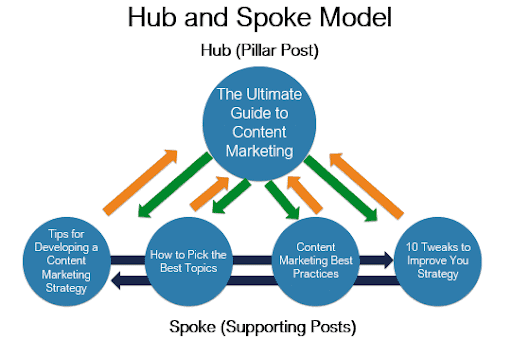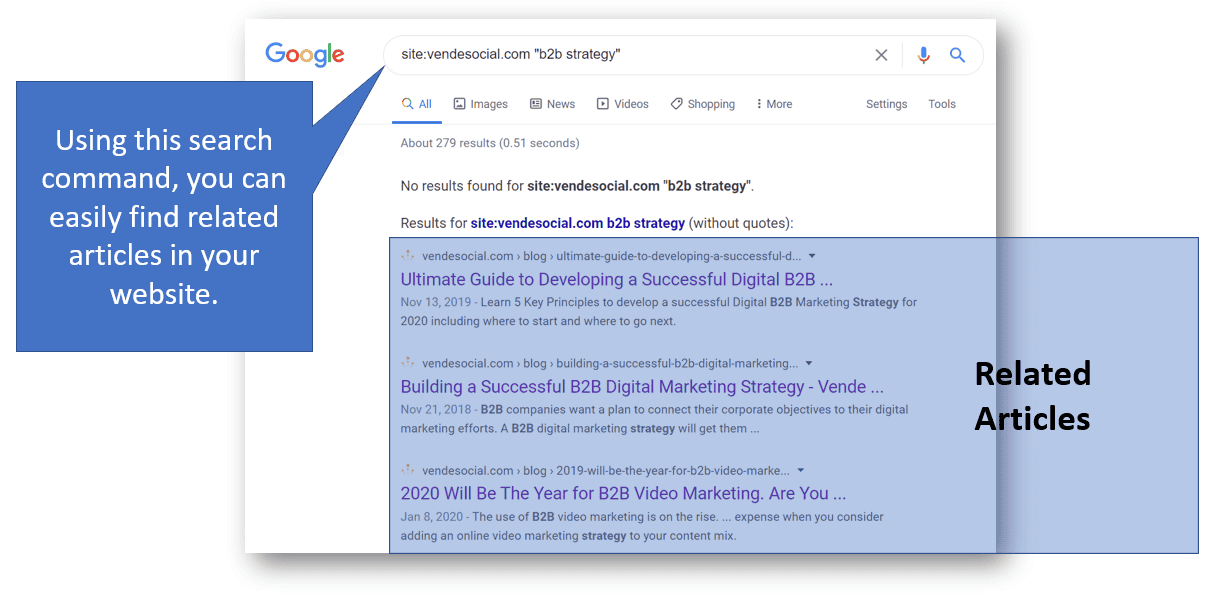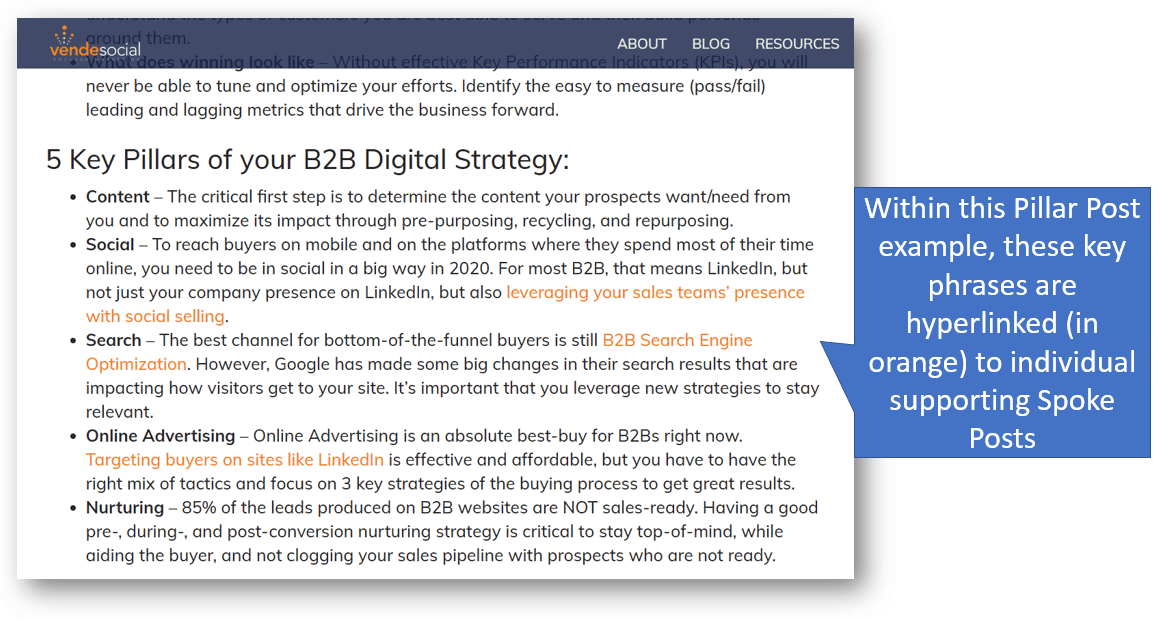
Fine Tune Your B2B Content Marketing Strategy Using the Hub and Spoke Model
Learn the 8 easy steps to incorporate a hub and spoke model into your B2B content strategy and skyrocket your blog traffic over the next 90 days.
Fine Tune Your B2B Content Marketing Strategy Using the Hub and Spoke Model
Recently NASA and Elon Musk's SpaceX Company launched a historic test flight with NASA astronauts using the Crew Dragon spacecraft built by SpaceX. Watching the historic event on my couch with my family brought back memories of my youth when NASA was launching people into space and exploring the outer reaches of our solar system with more frequency. I am excited to see a renewed interest in outer space.
So what’s NASA and SpaceX got to do with B2B content marketing?
Today, it takes a team effort to launch astronauts into space, and a similar effort is needed to skyrocket your blog traffic. To achieve maximum return on effort (more traffic to your blog) with B2B Content Marketing, a Hub and Spoke model works best by leveraging several blog posts that work together around a key topic that is important to your prospective customer.
What is The Hub and Spoke Model in B2B Content Marketing?
The Hub and Spoke model in B2B content marketing is a content planning and development strategy that centers around developing several posts around an important topic and interlinking the posts together. By having several posts individually focused on unique key phrases that are also related to an important topic; and then interlinking the posts together, you create a cluster of content that is irresistible to the Google crawler and are rewarded with skyrocketed listings and traffic.
Key Elements of the Hub and Spoke Model
The Hub and Spoke model consists of several elements working together as a team (just like NASA and SpaceX):
Content Plan - Obviously, your content plan will drive what content gets developed over time; no model can be successfully implemented without a plan. Here is a useful planning doc (Google Sheet) to help you organize your content strategy.
Topic Cluster - A topic cluster is a group of topics surrounded by a primary topic. For example, this article you are reading is part of a topic cluster about the primary topic of B2B Content Marketing. The topics in your cluster become the themes for your blog posts.
Hub Post - The Hub Post (aka Pillar Post) is a blog post that is focused on the primary topic within the topic cluster. We often entitled our Hub Posts as “The Definitive/Ultimate/Essential Guide to [Primary Topic].”
Supporting Spoke Posts - Spoke Posts are supporting articles that round out the topic cluster by providing content on the related topics. For example, this post is a related Spoke Post for our B2B Content Marketing topic cluster.

Benefits of The Hub and Spoke Model in B2B Content Marketing
Beyond skyrocketed traffic, your efforts will be rewarded when you implement the Hub and Spoke model for your business. Here are just a few:
- Customers love it - This model is beneficial to prospects because it allows them to essentially “scratch the surface” and learn your point of view on a particular topic by reading just one post or to take a “deep dive” into your thought leadership by consuming multiple articles. When you customers and prospects love your content, you will be rewarded with more leads.
- Google loves Hub and Spoke even more - This is where the skyrocketing traffic comes in. Content marketing will absolutely improve your search engine rankings and SEO. Google has evolved to understand user intent beyond simple keywords. “Restaurants near me” will pull up restaurants in your area even if you don’t include your town in your search. Today Google uses machine learning and related context to understand user intent. The Hub and Spoke model gives the Google algorithm additional information about topics and how they are related. In return, Google will index more of your blog posts and reward them with higher rankings, resulting in more traffic to your website.
- The Hub and Spoke model keeps your team focused on important topics - By approaching your B2B content marketing strategy with this model, you will be assured that your team is not picking topics out of thin air but rather focusing on content that will engage your audience. This will also make your social media content more consistent and on point.
6 Steps for Implementing the Hub and Spoke Model
Focus on the following 6 steps to get a Hub and Spoke model integrated into your B2B content marketing strategy. Additionally, we have created a Hub and Spoke worksheet to guide you through the process.
Step 1: Create topic clusters around key products, services, problems, needs or wants
The topic clusters you develop need to accomplish three goals: 1) Provide useful information to your customer, 2) Align with your subject matter expertise, 3) Have enough search volume to make it worth the effort (remember the goal is to skyrocket your traffic).
Start by brainstorming around your products and services. Then consider common issues/problems/challenges your customers are facing or major industry trends. If you are using our worksheet, put these topic ideas in column A.
Step 2: Determine the pillar (Hub) topic/post
Looking at your topics, think about which ones could be developed into an ultimate guide that would be beneficial to your customers. For example, this article is a support Spoke Post for a topic cluster about B2B Content Marketing. For us, it makes more sense for Content Marketing to be our Hub Post as it is a more comprehensive topic.
Not every topic in column A will become a Hub post. Many of them will be used as Spoke posts. Using our worksheet, pick the Hub post topics by adding a working title in Column B.
Pro Tip: You can easily convert a pillar topic into a premium piece of content. For example, a gated downloadable PDF, webinar, PowerPoint/slideshare presentation, video, etc.
Step 3: Come up with supporting (Spoke) posts
Now that you have your Hub topics flushed out, you can start thinking through topics for your supporting Spoke posts. In our worksheet, we have provided idea prompts starting in column E. Also, consider the outline of your Hub post. Many of the key points of the outline could also become a supporting Spoke post. Think of the Spoke post as a deeper dive on the subject. You can also conduct key phrase research and look for related long -ail search terms that would make good supporting Spoke posts.
Step 4: Inventory existing content that can be utilized
If you have been blogging for a while, more than likely, there are previously written posts that can be integrated into your Hub and Spoke model. This is great news! You don’t have to start from scratch. However, you will want to “freshen up” these older posts to ensure they are still current and also include links to the Hub post and other supporting Spoke posts.
Pro Tip: Use this search in Google to easily identify the best previously written content for your Hub and Spoke strategy.
Site:YourWebsite.com “pillar topic” for example site:VendeSocial.com “Content Marketing”

Step 5: Develop the interlinking strategy
This is the most important step in the process. It is critical that you hyperlink key phrases from each Spoke Post to the Pillar post and at least one other Spoke Post. You will also need to include one hyperlinked key phrase from the Pillar Post to each Spoke Post.

Step 6: Start executing
Now you have everything you need to start developing content for content strategy using the Hub and Spoke model. You can use the worksheet to document creation dates for each article and then manage your team to get the work completed.
Pro Tip: Pre-purpose by lifting key concepts from your Hub and Spoke articles to be used as social content.
Key Takeaways
Taking the time to integrate a Hub and Spoke model into your B2B Content Strategy will pay off in dividends with happier prospects and skyrocketed traffic to your website.
- The Hub and Spoke model benefits your customer by giving them your perspective on important topics.
- New Google advances make the Hub and Spoke model a great source of search engine traffic to your website.
- Start by creating topic clusters, then decide on your Hub and Spoke posts (blog articles)
- You can leverage content that has already been written into your Hub and Spoke model
The Hub and Spoke model may not be as exciting as launching astronauts into space; however, you now have the key steps you need to take to skyrocket your traffic. I promise you it won’t take as much work as it took for NASA and SpaceX.

How Can We Help?
Do you need help developing a content marketing strategy for your business? We offer strategic planning and content production services for B2B companies. If you are interested in learning more, sign up for a complimentary initial consultation/discovery meeting. Schedule yours today, and let’s see if we can help.







